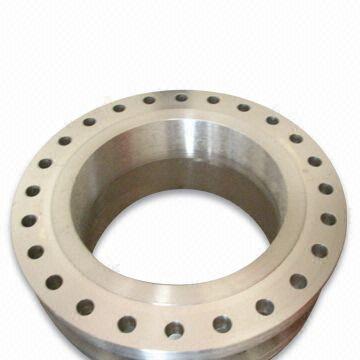The Research Method of Tightness of Bolted Flanges
 Sealing and leakage of bolted flanges
Sealing and leakage of bolted flangesIn the past, people thought of the bolted flange connection being completely sealed or no leakage at the joint as that the pre-tightening pressure force on the gasket in the pre-tightened state cannot be less than the pre-tightened seal specific pressure y of the gasket in the operating state, and the ratio of the residual pressing force on the gasket to the operating pressure is greater than or equal to the gasket coefficient m. On the contrary, if the joint is not sealed, leakage will occur. The leakage rate shows that there is no bolted flange with complete sealing or leakage, but the degree of leakage at the joint is different. Therefore, the sealing requirement for certain equipment or pipeline is to require its leakage rate to be less than or equal to the specified value.
For bolted flanges, the sealing condition is related to many factors such as the surface roughness of the flange's sealing surface, operating conditions, compression stress, gasket material characteristics, shapes and sizes, physical properties of the sealed medium, loading and unloading history.
(1) The influence of the surface roughness of the flange's sealing surface
Under the same bolt stress, the roughness of the sealing surface of the flange is small, and the corresponding concave-convex area is also small, so that the interface leakage area can be greatly reduced and the leakage rate is reduced. The flange sealing surface of small roughness has a better effect than that of great roughness.
(2) The influence of operating conditions
The working conditions of the sealing of bolted flanges mainly include medium pressure and working temperature. The amount of the leakage rate will change with the change of pressure and temperature. The greater the pressure difference between the sealing surfaces of the two flanges, the easier it is for the medium to overcome the resistance of the medium leakage, and the easier it is for leakage to occur. Studies have shown that temperature has a great influence on the sealing performance of bolted flanges. With the increase of temperature, the viscosity of gas or liquid increases or decreases correspondingly; gasket aging and relaxation increase, creep of materials occurs, and leakage is more likely to occur.
(3) Influence of bolt pre-tightening force
One of the main factors to ensure the sealing of bolted flanges is the control of bolt pre-tightening force. When the bolt pre-tightening force is applied, it must be slow and uniform. Otherwise, it is not easy to cause uneven deformation of the flange surface, and the flange will be warped and deflected at this time. Under normal circumstances, the greater the pre-tightening force is applied, the greater the pressure generated per unit area of the gasket becomes, and the greater the deformation on the sealing surface is, which will compress the capillary pores on the gasket surface to fill the uneven gap on the flange surface, resulting in increasing the resistance of the medium leakage and the leakage being greatly reduced. However, if the applied bolt pre-tightening force is too great, it is likely that the flange sealing surface and the gasket surface will be crushed, resulting in failure of sealing and leakage. At present, the method of tightening bolts in China is to use a sleeve impact wrench. Because of the poor bolt lubrication, the bolt pre-tightening force often fails to meet the requirements, or even differs greatly, which causes safety hazards.
(4) The influence of the physical properties of the medium
The physical properties of the medium, such as the form, density, and viscosity also have a great influence on the sealing of the bolted flanges, among which the viscosity has the greatest influence. For the same bolted flange, under the same working conditions, the leakage rate of gas is generally greater than that of liquid, and the low viscosity has a higher leakage rate than high viscosity.
(5) The influence of the geometry of the gasket
The influence of gasket geometry on the sealing performance of joints mainly depends on the thickness and width of the gasket. Within the specified conditions, the thicker and wider the gasket is, the smaller the leakage rate of the sealed joint will be. The thickness and width of the gasket are required to be within a certain range. When the thickness of the gasket reaches a certain value, the penetration leakage rate will increase accordingly. If the width reaches a certain value, a larger bolt pre-tightening force is required. The sealing of bolted flanges is improved.
Next: Reasons for Cracks of Flanges
Previous: An Introduction to Flanges' Connections
Related News
- Failure Analysis of Cracking in a 16MnⅢ Weld Neck Flange
- ANSYS Analysis for Anchor Flange Structural Optimization
- Flange Leakage in Hydrogen-Cooled Pipeline Systems of Thermal Power Plants
- Flange Sealing Technology and Installation Method for Hydrogenation Units
- Multi-Directional Die Forging Process for Horizontal Valve Bodies with Dual Flanges
- Structural Performance Analysis of Zirconium Pressure Vessel Lap Joint Flanges
- Low-Temperature Flange Sealing Solutions for Cryogenic Chemical Pipelines
- Innovative Technology for Automatic Alignment in Underwater Flange Assembly
- Stamped Steel Slip-On Flanges
- Design and Finite Element Analysis of Anchor Flanges for Oil & Gas Pipelines
